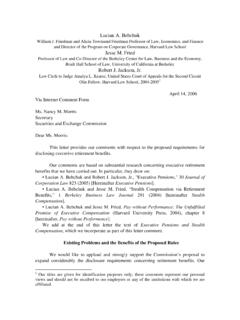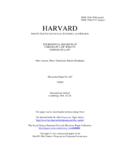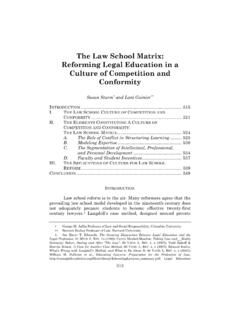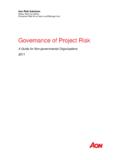Transcription of ISSN 1045-6333 HARVARD
1 Electronic copy available at: issn 1045-6333 HARVARD JOHN M. OLIN CENTER FOR LAW, ECONOMICS, AND BUSINESS LEARNING AND THE DISAPPEARING ASSOCIATION BETWEEN governance AND RETURNS Lucian A. Bebchuk, Alma Cohen, and Charles C. Y. Wang Discussion Paper No. 667 04/2010 HARVARD Law School Cambridge, MA 02138 This paper can be downloaded without charge from: The HARVARD John M. Olin Discussion Paper Series: The Social Science Research Network Electronic Paper Collection: This paper is also a discussion paper of the John M.
2 Olin Center's Program on Corporate governance Electronic copy available at: Learning and the Disappearing Association between governance and Returns Lucian A. Bebchuk,* Alma Cohen,** and Charles Wang** Abstract In an important and influential work, Gompers, Ishii, and Metrick (2003) show that a trading strategy based on an index of 24 governance provisions (G-Index) would have earned abnormal returns during the 1991-1999 period, and this intriguing finding has attracted much attention ever since it was reported.
3 We show that the G-Index (as well as the E-Index based on a subset of the six provisions that matter the most) was no longer associated with abnormal returns during the period of 2000-2008, or any sub-periods within it, and we provide evidence consistent with the hypothesis that the disappearance of the governance -returns association was due to market participants learning to appreciate the difference between firms scoring well and poorly on the governance indices. Consistent with the learning hypothesis, we document that (i) attention to corporate governance from the media, institutional investors, and researchers has exploded in the beginning of the 2000s and remained on a high level since then, and (ii) until the beginning of the 2000s, but not subsequently, market participants were more positively surprised by the earning announcements of good- governance firms than by those of poor- governance firms.
4 Our results are robust to excluding new economy firms or to focusing solely on firms in non-competitive industries. While the G and E indices could no longer generate abnormal returns in the 2000s, their negative association with Tobin s Q persists and they thus remain valuable tools for researchers, policymakers, and investors. Keywords: Corporate governance , governance indices, shareholder rights, entrenchment, market efficiency, learning, abnormal returns, earning announcements, analyst forecasts, IRRC provisions, behavioral finance, asset pricing.
5 JEL Classification: D03, G10, G12, G30, G34, K22 * HARVARD Law School and NBER. ** Tel-Aviv University Eitan Berglas School of Economics, HARVARD Law School, and NBER. ** Stanford University Department of Economics. For financial support, we would like to thank the John M. Olin Center for Law, Economics, and Organization. Electronic copy available at: Introduction In a seminal paper, Gompers, Ishii and Metrick (2003) (hereinafter GIM) identified a governance -based trading strategy that would have produced abnormal profits during the period 1990-1999.
6 This strategy was based on a G-Index that GIM constructed on the basis of 24 governance provisions that weaken shareholder rights. These intriguing findings have attracted a great deal of attention ever since they were first reported, and the G index (as well as the E index that is based on a subset of these 24 provisions (Bebchuk, Cohen, and Ferrell (2009)) has been extensively used. As of March 2010, the GIM study has about 800 citations on SSRN. In this paper, we contribute to understanding GIM s celebrated results concerning the association between governance and abnormal returns.)
7 We show that the G-Index (as well as the E-Index) was no longer associated with abnormal returns during the period of 2000-2008 (or any sub-periods within it) and we provide evidence consistent with the hypothesis that the disappearance of the governance -returns association was due to market participants learning to appreciate the difference between well-governed and poorly-governed firms. Our analysis highlights the changes over time in market participants attention both to corporate governance in general and to differences between good- governance and poor- governance firms, as well as the role that such changes played in incorporating governance into market prices.
8 Our findings are consistent with market learning about the benefits of governance being responsible both for the governance -return association during the 1990s and for its subsequent disappearance. GIM suggested that governance provisions or the characteristics of firms governance and culture that they reflect are associated with lower firm value and performance. In particular, GIM showed that higher G-Index scores are associated with lower industry-adjusted Q, lower profits, lower sales growth, and more corporate acquisitions.
9 Subsequent work found additional links between the G and E indices and firm performance. For example, Masulis, Wang and Xie (2007) find that worse G-Index and E-Index scores are correlated with worse acquisition decisions (as measured by the stock market returns accompanying acquisition announcements), Dittmar and Mahrt-Smith (2007) finds that worse such scores are correlated with a less valuable use of cash holdings. That the G-Index and E-Index are associated with lower firm value and worse firm performance, however, does not imply that these indices should be associated with abnormal stock returns.
10 To the extent that market prices already reflect fully the differences between well- 1governed and poorly-governed firms, trading on the basis of the governance indices should not be expected to yield abnormal profits. One possible explanation for the GIM findings is that governance is correlated with some common risk factor that is not captured by the standard four-factor model used by GIM to calculate abnormal returns (Core et al. (2006), Cremers et al. (2009)). Under this explanation, governance can be expected to continue to play a role in cross-sectional regressions of returns as long as the common risk factor correlated with governance continues to have such a role.



















